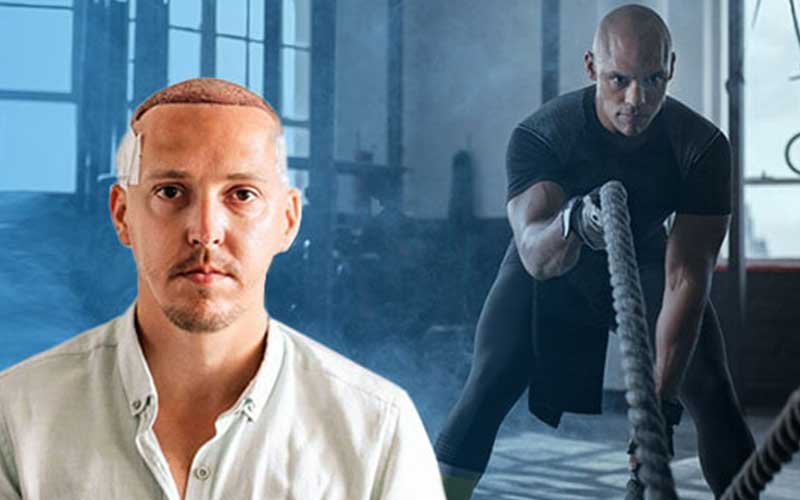Exercise and Physical Activity After Hair Transplant | Expert Advice for Fast Recovery and Long-Lasting Results

Exercise and Physical Activity After Hair Transplant | Expert Advice for Fast Recovery and Long-Lasting Results
Introduction
A hair transplant is a proven and effective solution for restoring a natural hairline and boosting confidence in individuals dealing with hair loss. However, one of the most frequently asked questions after undergoing this cosmetic procedure is:
“When can I start exercising again, and how should I manage physical activity?”
The recovery period following a hair transplant is crucial. Improper exercise or physical strain can negatively affect the outcome and damage newly transplanted grafts. In this article, we explore professional recommendations for safe physical activity after a hair transplant, guided by the expertise of Dr. Mojtaba Mostafazadeh at Sepanta Center.
Why Should You Be Cautious with Exercise After a Hair Transplant?
During a hair transplant, follicular grafts are extracted from the donor area and placed into the recipient area. These grafts are extremely delicate during the initial healing phase. Exercising too soon or too intensely may lead to:
-
Excessive sweating and bacterial growth
-
Friction or accidental trauma to the scalp
-
Increased blood flow to the head, causing bleeding or graft dislodgement
-
Inflammation and scalp irritation
According to Dr. Mojtaba Mostafazadeh, developing a phased and personalized return-to-activity plan is critical to preserving the results of your hair transplant.
Timeline for Returning to Exercise After a Hair Transplant
First Week: Total Rest and No Activity
Avoid any type of physical activity, including long walks, stair climbing, or bending over. Excess sweating and head movement must be strictly minimized to protect the new grafts.
Second Week: Resume Light Activities
From day 8 onward, gentle activities like slow walking may be resumed. However, cardio workouts, weightlifting, or any form of intense activity remain off-limits. Avoid hats or anything that might touch or press against the scalp.
Weeks 3–4: Gradual Activity Reintroduction
Low-impact exercises such as yoga, stretching, or light cycling may be performed with caution. Still, avoid contact sports or any physical friction to the scalp.
After One Month: Moderate Exercise Allowed
By the fourth week, most patients can return to moderate-intensity workouts like jogging or light resistance training. Care must still be taken to avoid trauma or direct impact to the scalp.
After 6 Weeks: Resume Full Physical Activity
If healing has progressed well and no inflammation or scabbing is present, high-intensity training or contact sports may resume. A final checkup with your specialist is recommended before restarting rigorous activity.
Top Tips for Exercising After a Hair Transplant
-
Avoid excessive sweating, especially in the first three weeks
-
Do not wear tight hats or headbands
-
Wash your scalp with cool water after mild activity (starting week 2)
-
Stay hydrated and get enough sleep for better healing
-
Consult your doctor before taking supplements or pre-workout formulas
-
Protect your scalp from sun exposure and impact
Sepanta Center’s Personalized Approach for Athletes
At Sepanta Hair Transplant Center, led by the experienced Dr. Mojtaba Mostafazadeh, each patient receives a customized post-transplant care plan. Whether you’re a professional athlete or a fitness enthusiast, Sepanta provides specialized recovery guidance to ensure your hair transplant results are protected while you safely return to your active lifestyle.
Frequently Asked Questions About Exercise After Hair Transplant
Can I go back to the gym after one week?
No. Even light gym workouts involve heat, friction, and potential sweat buildup, which can be harmful in the first week.
Is yoga or meditation allowed?
Yes, but only after the second week and with gentle, non-inverted positions to avoid blood rush to the scalp.
When is it safe to swim?
Swimming, especially in chlorinated pools, is typically not recommended until 6 weeks post-op to prevent irritation and infection.
Conclusion
Exercising after a hair transplant is not only possible but beneficial when done correctly and with timing in mind. A structured return to activity protects your new grafts and supports full recovery. With proper planning, expert guidance, and a bit of patience, you can enjoy both a healthy body and healthy hair.
For tailored advice and expert post-transplant care, schedule a consultation with Dr. Mojtaba Mostafazadeh at Sepanta Center — your trusted destination for advanced and personalized hair restoration.
